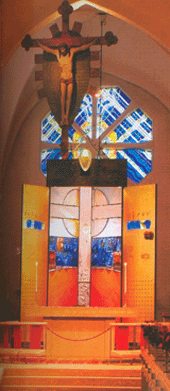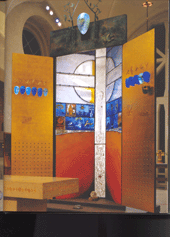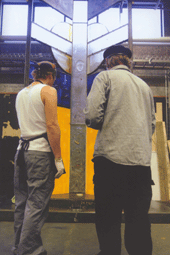| "My
most important work of art!" Was BV's comment on the commissioned
altarpiece in Växjö Cathedral. His questing nature merged
with an aspiration for a spiritual dimension in his art by encapsulating
light together with symbols.
The Cathedral
in Växjö can hardly be accused of making hasty decisions.
The competition relating to a new altarpiece went on for almost
a decade. Throughout this time the theme has been: "The journey
of life from darkness to light". Some hundred artists have,
with furrowed brow, pondered long and hard before submitting their
proposals - some of which are undoubtedly very good, while others
are both stylistically and financially unviable. A number of factors
must agree if a proposal is to survive even the first round
.
Embellishing a church is no easy task. Especially in the case of
an altarpiece, which constitutes the main focal point (in a church).
There are several aspects to be considered by the artist - the religious
(Christian) symbolism, as well as the historical and architectural
aspects. The trivial, or ridiculous has no place here. The Church
stands for strength and stability, solemnity, and joy.
In the
final round of the competition, 1998, two candidates remained: namely,
Monica Backström (Boda) and Bertil Vallien (Åfors). Admittedly,
neither of them were new to the work of public decoration, churches
included. Witness Backström's stained-glass window for the
Påskallavik church, and Vallien's sandcast crosses and baptismal
fonts in Höör, Linköping and Uppsala.
The result of the competition was announced in May, 1999: Bertil
was to carry out the work. Three years later the altarpiece was
completed - a scintillating masterpiece that captures to perfection
the theme of the journey from darkness to light.
With
a height of five and a half metres, the altarpiece is a monumental
creation The doors, which are four metres high, each contain six
small blue glass heads, representing the twelve apostles. When closed,
the altarpiece has an austere rectangular appearance; the surface
colour - a greyish-bronze - is made from a blend of wax and rosin.
The upper part of the piece is dominated by a sand-cast head of
Christ, with a crown of thorns wrought in metal.
When the doors are opened a world of light is revealed. A large,
embosoming cross, constructed from blocks of sand-cast glass, forms
the central point* of the piece. The back of the doors are painted
gold, symbol of eternity. The lower part of the doors are perforated
with small holes to form a chequered pattern. The holes signify
mankind. The triangular shaped walls, a feature echoed in the cross,
are painted in red and orange. The background of the upper part
of the cross is sky blue.
Both
sides of the cross are flanked by blue tiles, which on closer inspection,
turn out to be sixteen sand-casted blocks of cobolt-blue glass.
Their stylised motifs relate to episodes from the Old and New Testaments:
Adam and Eve, The Serpent's temptation, the Arc of the Covenant;
Jacob's ladder; Moses and the Tablets, King David, The Song of Songs;
The afflictions of Job, The Madonna and Child ; The Magi; the casting
out of the merchants from* the Temple; The Sermon on the Mount;
The Good Samaritan, The head of John the Baptist, Mary Magdalene
and the miracle of the five loaves and three fishes.
The Cross
rests on a large head. The glass cubes in the lower half of the
cross have a darker tone, which is echoed in the background colour
of the wall. The large head is encircled in *black, which gives
way to the fiery flames of Hell. The glass blocks in the upper part
of the cross are transparent and in the middle is a circular, clear
glass Mandela - "Rex Gloriae". On the back of the altarpiece
there are a number of symbols, including the three cardinal virtues:
Faith (cross), Hope (anchor) and Charity (heart). Here, too the
sixteen glass blocks now have a more expressive appearance.
Author
Gunnar Lindqvist (Vallien's biographer) sees the altarpiece as a
further endeavour to isolate the spiritual light in his glass artefacts.
Lindqvist ends his book about the altarpiece, "Fiat Lux - and
there was light", with these words:
"It
is in the endeavour to capture the heavenly light, a light so powerful
to man, that the altarpiece in Växjö may be seen as a
masterpiece of innovation. By harnessing the medieval view of divine
light, BV's modern working methods, have, paradoxically, laid the
basis for artefacts that embody the medieval vision of the guiding
light of paradise."
In 1998,
while the competition was still in progress, Bertil described the
altarpiece, and his thoughts relating to the message of the church,
spirituality and death:
What
ideas underlie the altarpiece?
- The
first concern is Brazda's stained-glass windows at the back of the
cathedral. Then there's the chancel (altar room) to consider. I
have tried to tackle the problem on the basis of architectonic principles,
by creating a shape that reinforces the space and is not too clumsy.
l
The doors of the altarpiece can be opened and closed - which is
quite fun (interesting), and I hope the ministers will think so
too. It's a good solid construction, the doors are four metres high
- I can imagine it being quite effective when the doors are opened
before the congregation.
-When
closed, the altarpiece is dark and subdued, and enigmatic. When
opened, it's a shimmering spectacle of red, gold and orange. The
effect/emotional impact* of opening is crucially important...and
marks a new phase - it symbolises the opening of the doors of heaven.
It's the fundamental architectural idea of the altarpiece, one might
say - as an experience of spatial form.
What
significance does a church have for you/mean to you?
-I don't
profess to be a practising Christian. But as I was born in Sweden,
and into a non-conformist home, to boot, it goes without saying.
Our entire history and moral-code is based on Christianity/the Christian
ethic.
But apart from that, I see the church as one of the few places of
refuge/sanctuaries in the community. When I enter a church I'm seized
with religious fervour and take off my hat.
-It's
the message and what the church represents: heaven on earth, but
also the respect that the edifice itself inspires, and the people
who come here. Many of them have a special reason for coming - they
seek peace and comfort. Another aspect is the stability of the church.
It's different with the decoration of a bank, or university; you
know that in five years time a computer, or copying-machine will
have been installed, or a floral arrangement. People care more about
the interior of a church.
What
does spirituality mean to you?
- What
spirituality is? It's having a connection with, and belief in the
irrational. Finding values in life that cannot be explained. Hope
and trust in a life after death. I believe that there are feelings
and emotional moods/atmospheres that cannot be corroborated/controlled/explained
in a rational way. Spirituality may take the form of listening to
music. When you listen to music you can find values and connect
with your inner self or with other worlds. It's the same with art,
you might ponder/think about the mechanisms by which a person lives
and thinks. Where love and romance comes in.
Can Art
alleviate people's suffering?
- I think
music is the most wonderful medium of all. The most fantastic form
of communication and of art there is, because it's so abstract.
With music, we accept the fact that it doesn't represent anything
more than what arises in our own hearts and heads. That's the nice
thing about music. And of course, music can inspire me to work.
It can make me happy or stir me, according to the harmonic mood.
Good theatre, film and art also has a similar effect. They impart
knowledge and highlight issues that one has pondered about. I believe
that the essence of art is to convey new experiences.
What
is your view of Death?
-I'm
terrified of dying. Insofar as I think about it. Which is quite
often as one gets older or when one comes into contact with it,
it's frightening. I'd be lying if I said otherwise. Death is inexorable.
Everything just comes to an end. Is that really how it is?
|

Sketches
for the sandcasted glassblocks. Scenes from the Old Testaments.
Photo: Hans Runesson.

Bertil
do some sketching. Photo: Hans Runesson.

Bertil
togheter with Åke Edvardsson during the sandcasting. Photo:
Hans Runesson.

The
altarpiece in Växjö Cathedra. Photo: Tord Lund.

A close - up. Photo: Anders Qvarnström.

The
backside of the altarpiecet.
Photo: Anders Qvarnström.

The
altarpiece with closed doors. Photo: Anders Qvarnström.

Bertil
with his assistent Per Gunnar Johansson. Photo: Hans Runesson.
|


